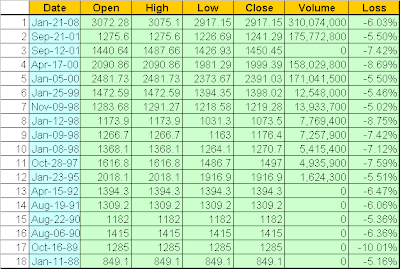20 Sept 2008
Introduction
When investment giant, Lehman Brothers, filed for bankruptcy, some local investors received calls from DBS Bank, warning them that their investment in the DBS High Notes 5 may be at risk and the investors may only get a portion of their investment back or none at all. Some had invested S$50,000 while other had invested much more.
What is DBS High Notes ? DBS High Notes are structured “first-to-default” credit linked notes, linked to a basket of stocks traded in SGX or NYSE or other World markets. The companies of these stocks usually have a minimum credit rating of A+ by Standard and Poor. It is designed for investors who are mostly clients of DBS's priority banking unit. It is an alternative means for these investors to participate in stock market investment. DBS has more than 150 different types of structured investment as indicated in their
WebsiteWhat is DBS High Notes 5?DBS High Notes 5 is a 5-1/2 year structured product linked to eight underlying stocks that includes:-
a) Goldman Sachs;
b) Morgan Stanley;
c) Merrill Lynch;
d) Macquarie Bank and
e) Lehman Brothers.
DBS High Notes 5 was issued in 2007 and the maturity date is 16 Nov 2012. It is based on Singapore Dollars.
How Do They Payout?DBS will invest on behalf of the investors and pay interests to the investors at a rate of 3.5% - 5% per annum depending on the contract. In the case of High Notes 5, 5% per annum. The interest payment will stop when DBS redeems the Notes or when a Credit Event occurs. Normally, investors will receive 100% of their principal amount at final maturity;

but when there is a Credit event, the Notes will terminate automatically and the investors will receive only the Credit Event Redemption Amount(CERA).
 What is a Credit Event?
What is a Credit Event?The occurrence of any one of the following events to any stock in the basket as determined by DBS Bank Ltd, as a Calculation Agent for the Notes:-
(a) Bankruptcy
(b) Failure to Pay
(c) Restructuring
According to the contract, the Calculation Agent has the sole and absolute discretion as to when and whether to declare a Credit Event in respect of the Notes
How Do They Work Out the Credit Event Redemption Amount (CERA)? The amount will be calculated based on the following formula:
(Principal Amount x Final Price) - Unwind CostsWhat is Final Price ? The Final Price is the price of the stocks in the basket expressed as a percentage determined by the Calculation Agent; most probably, worked out based on the current stock price
What is Unwind Costs?The loss incurred by DBS, as determined by the Calculation Agent, for terminating, liquidating, obtaining or re-establishing any swap agreement, foreign exchange transaction, financing arrangement, investment or other financial transaction entered into by or on behalf of DBS in relation to the issuance of the Notes.
What will be the CERA for High Notes 5 ?To be worked out. According to Straits Times report on 20 September, High Notes 5 investors may get back some money by Credit Event Redemption Date, which is not later than 37 payment Days after the determination of the Final Price (the Valuation Date).
Disclaimer:
Information here is for sharing and learning. It is not intended to give any advice on price of any stock or movement or trend of any index. If a price or movment of a stock/index is given, it is only intended for illustration. The reader shall verify the information given here before using them.












